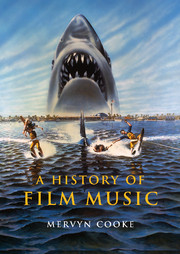Book contents
- Frontmatter
- Contents
- List of illustrations
- Preface and acknowledgements
- 1 The ‘silent’ cinema
- 2 Sound on track
- 3 Hollywood's Golden Age: narrative cinema and the classical film score
- 4 Stage and screen
- 5 The mainstream divides: post-war horizons in Hollywood
- 6 ‘Never let it be mediocre’: film music in the United Kingdom
- 7 Defectors to television
- 8 Film music in France
- 9 Global highlights
- 10 Popular music in the cinema
- 11 Classical music in the cinema
- 12 State of the art: film music since the New Hollywood
- Bibliography
- Index of film titles
- General index
12 - State of the art: film music since the New Hollywood
Published online by Cambridge University Press: 05 February 2015
- Frontmatter
- Contents
- List of illustrations
- Preface and acknowledgements
- 1 The ‘silent’ cinema
- 2 Sound on track
- 3 Hollywood's Golden Age: narrative cinema and the classical film score
- 4 Stage and screen
- 5 The mainstream divides: post-war horizons in Hollywood
- 6 ‘Never let it be mediocre’: film music in the United Kingdom
- 7 Defectors to television
- 8 Film music in France
- 9 Global highlights
- 10 Popular music in the cinema
- 11 Classical music in the cinema
- 12 State of the art: film music since the New Hollywood
- Bibliography
- Index of film titles
- General index
Summary
After the crisis in the Hollywood film industry attendant upon the 1948 rulings by which the studios lost their monopolies of distribution outlets, and fuelled by the stiff competition presented by the enormous boom in television viewing in the 1950s, film-makers had attempted to lure spectators back into theatres with widescreen spectacles (as we saw in Chapter 5). Escalating budgets and poor revenue conspired to make many of these high profile projects commercial failures, however, and the ailing studios came to realize that making feature films, documentaries and cartoons specifically for televisual broadcast – as well as generating income by selling existing films to television networks – was amore viable way of ensuring a ‘stabilized economics of distribution’ for its products (Neale and Smith 1998, xv). By the beginning of the 1960s,Hollywood had therefore become responsible for providing around 80 per cent of all American primetime television output, half of its contribution consisting of original material and half broadcasts of old films (Maltby 1998, 29). Shrewd executives tapped the lucrative television market before reinvesting in theatrical releases, a strategy demonstrated by Lew Wasserman, the President of MCA responsible for that company's purchase of Universal in 1962, and Steven J. Ross, whose Kinney Corporation absorbed Warner–Seven Arts to become Warner Communications, Inc. in 1969. Ross's empire, which among its activities included a pioneering belief in cable television, was an early example of the vertically integrated media conglomerate that later came to dominate a globalized entertainment industry (Gomery 1998).
- Type
- Chapter
- Information
- A History of Film Music , pp. 454 - 510Publisher: Cambridge University PressPrint publication year: 2008



